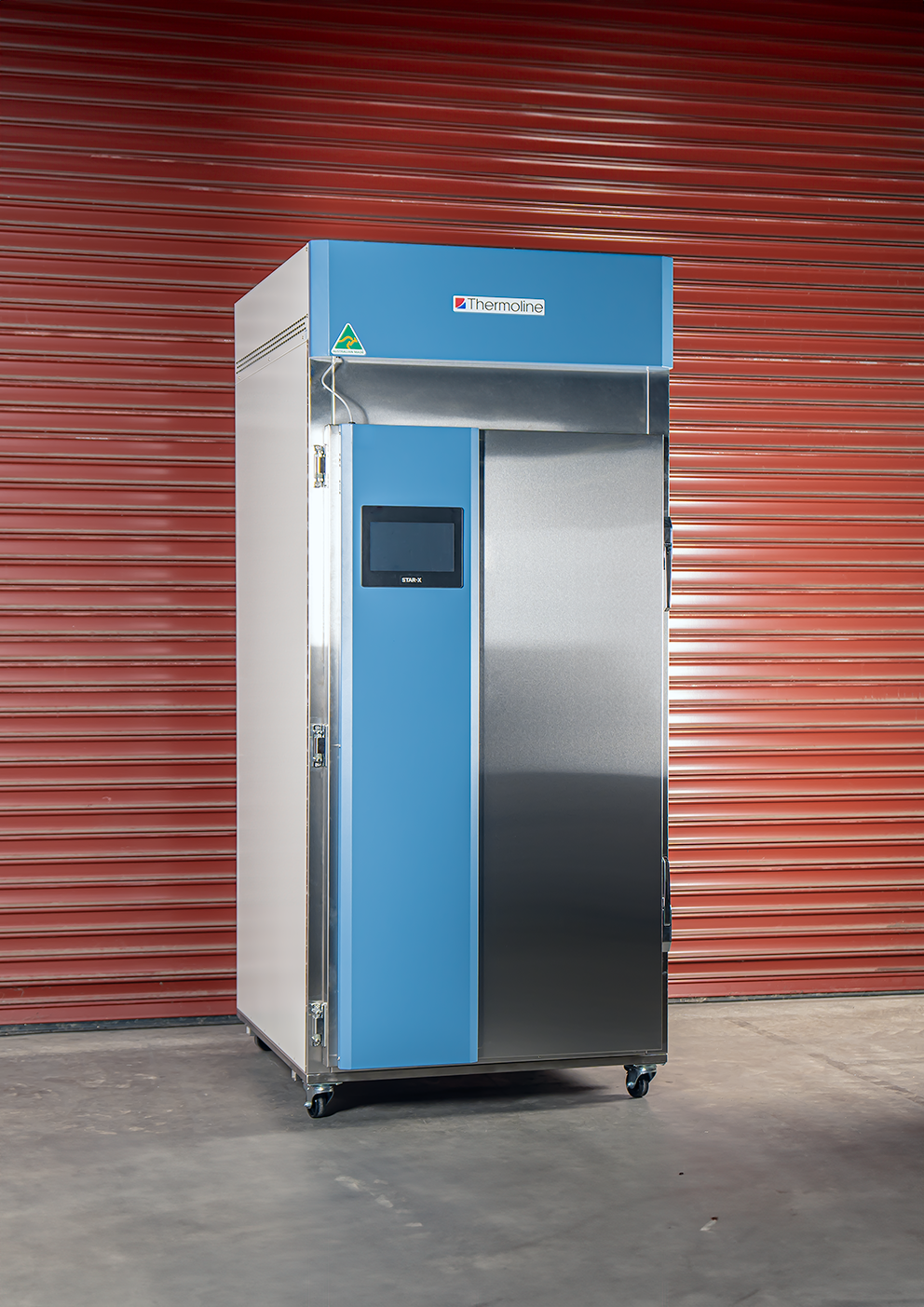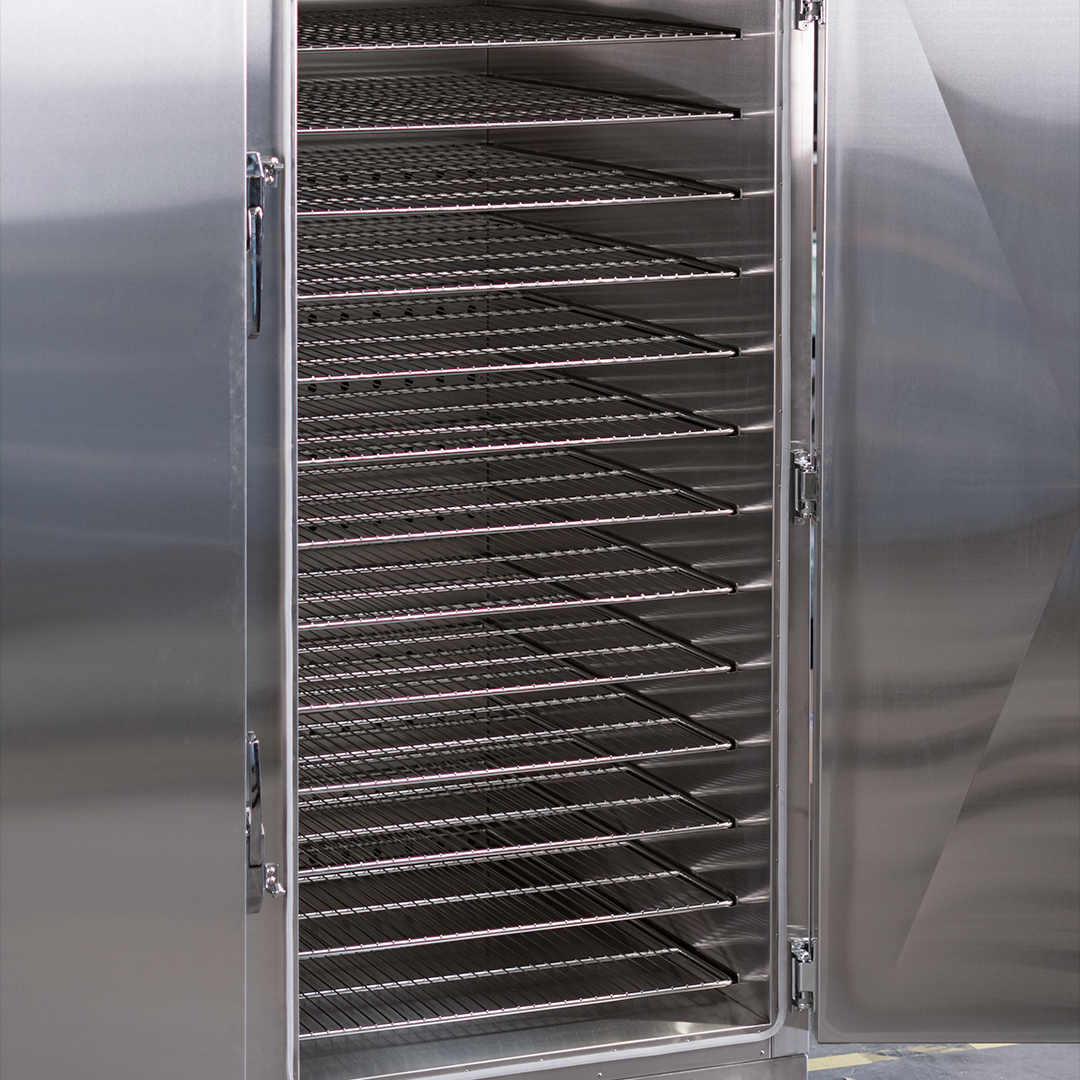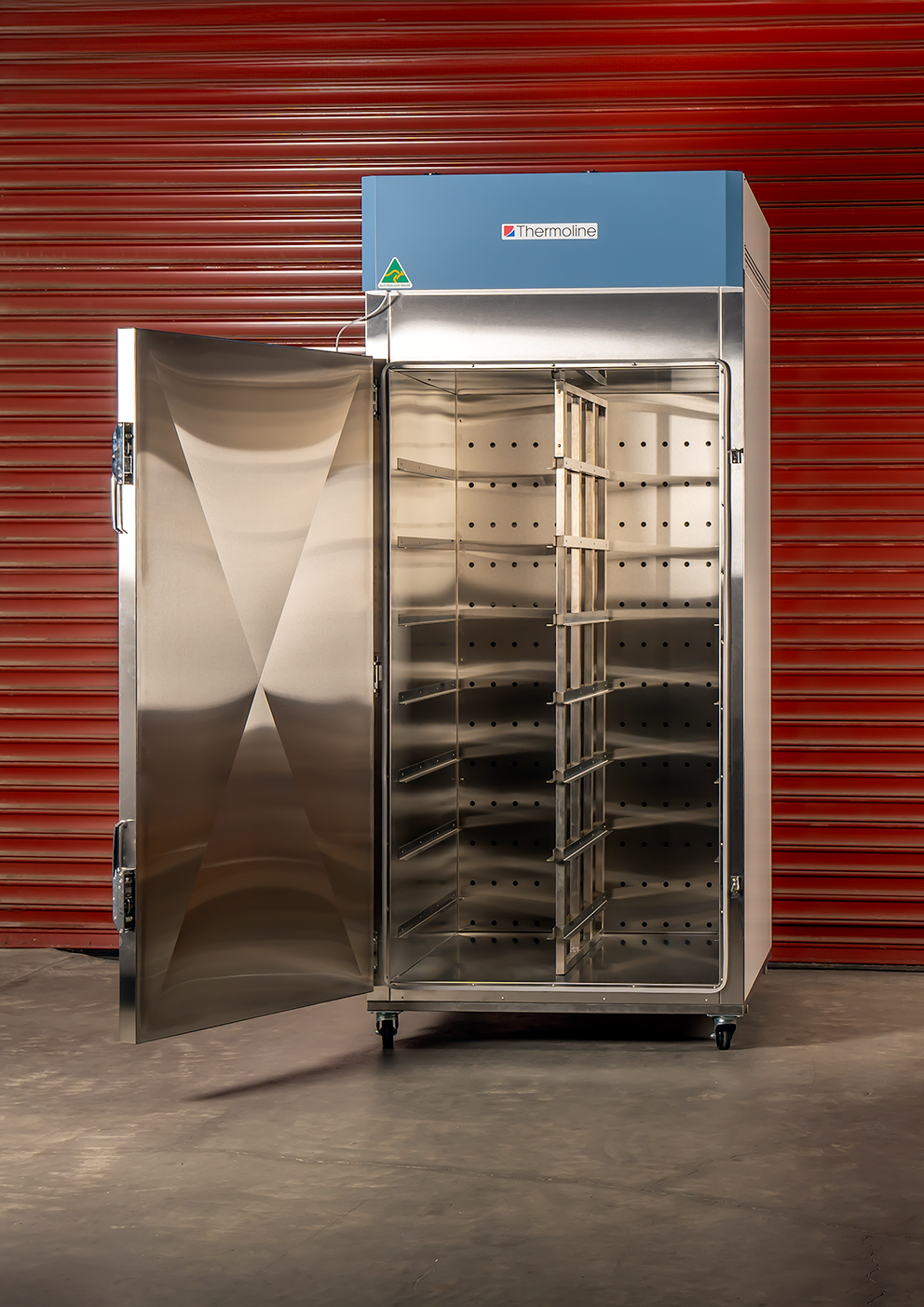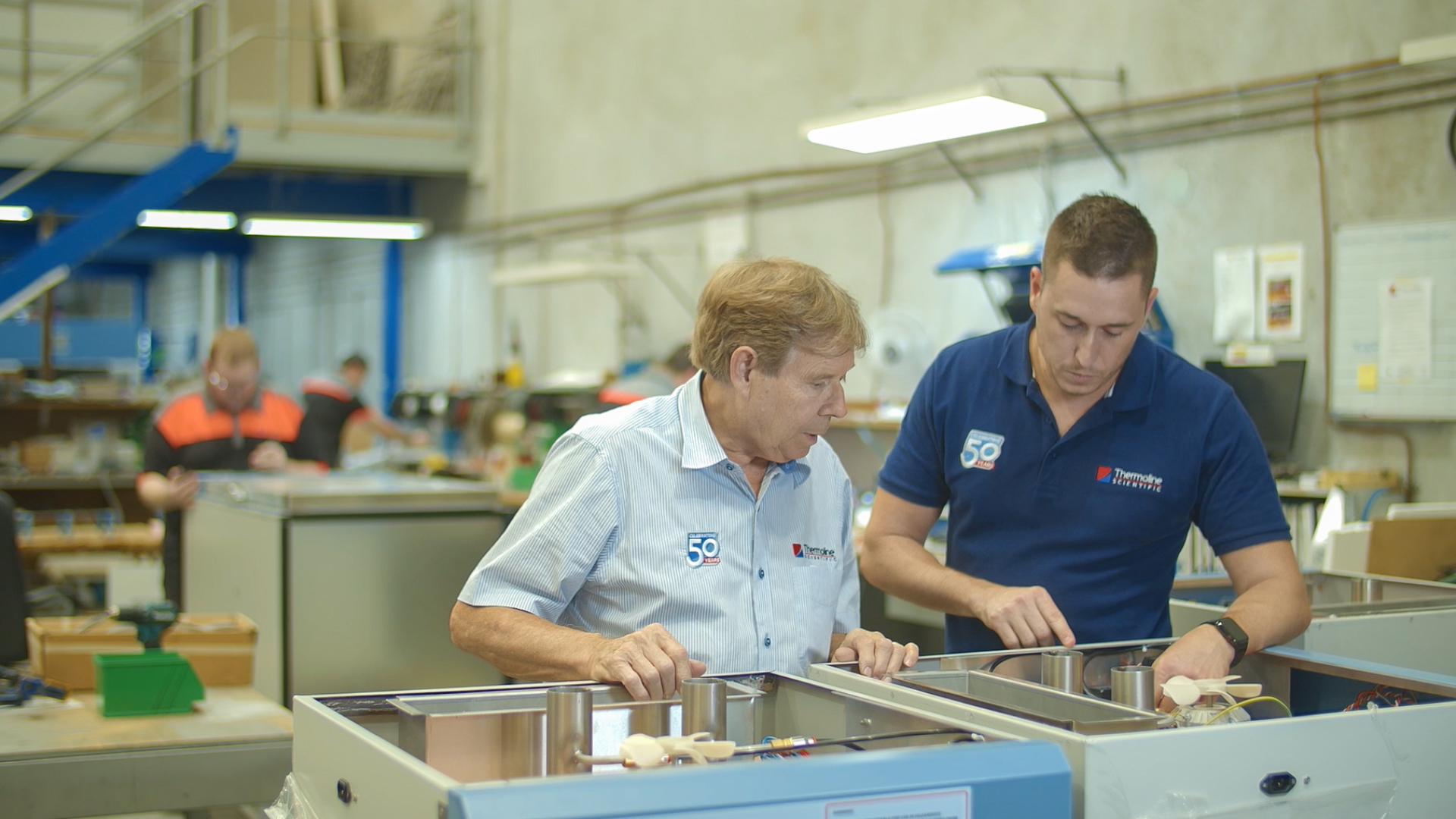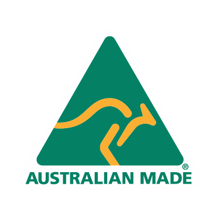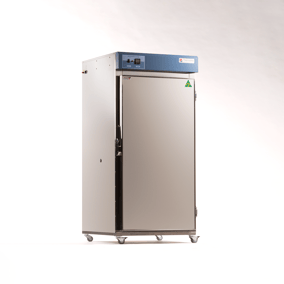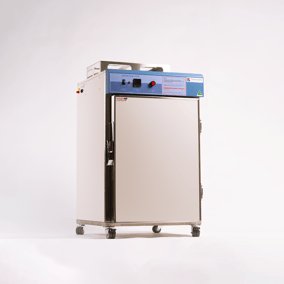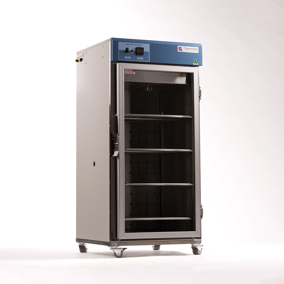Large Capacity Drying Oven TD (Large Capacity)
Thermoline has designed and manufactured these large capacity drying ovens with the assistance, and in consultation with the Department of Primary Industries, for the removal of moisture in large amounts of soils, however, these large dehydrating ovens will perform equally when loaded with other materials or samples.
Overview
The two-door TD-2400 is the largest drying oven in the Thermoline catalogue, featuring a huge 2400L capacity over 26 shelf or tray levels. Each level has the option of a single large open wire shelf, or either three solid or perforated trays (78 trays in total). The TD-1200 is the one-door version with 13 shelf or tray levels. Completely manufactured by Thermoline, these ovens are built with a 304 stainless steel interior for maximum corrosion resistance and an attractive Colorbond exterior finish. One or two large stainless steel doors open outwards to reveal the vast capacity inside.
Shelving Options
- Open Wire Shelves: Stainless steel shelves are 900x753mm. One shelf per level per door
- Perforated Trays: Stainless steel trays are 300x753mm and 50 mm deep. Standard perforations are 20mm in diameter at 80mm centres but can be customised to suit. There are three trays per level per door.
- Solid Trays: Stainless steel trays are 300x753mm with 50mm depth. Three trays per level per door
Advanced Control System
Both the TD-1200 and TD-2400 are powered by Thermoline's Select Touch And Run (STAR X) 10" touchscreen control system. The STAR X touchscreen control system offers easy programming of temperature control with standard features, including:
- 10" Rugged Touchscreen: A large, full-colour TFT LCD display with LED backlighting for clear visibility and ease of use.
- Real-Time Synchronisation: Allows the operator to synchronise programmed settings in real-time.
- Ethernet Connectivity: Enables the operator to perform all functions via a PC once connected.
- Data Logging: Logs the performance of the cabinet to onboard memory, holding up to 365 days of data. A live trend screen allows quick performance checks, and logged data can be downloaded to a USB flash drive for archiving or review via a PC using simple spreadsheet software like Microsoft Excel.
Industrial Applications
The TD-1200 and TD-2400 have also been used in the coal and mining industries. Drying coal reduces its moisture content, improving combustion efficiency, handling properties, and storage life.
Benefits
- Large Capacity: With the TD-2400's 2400L capacity and the TD-1200's 1200L capacity, these ovens can handle significant volumes, making them ideal for large-scale drying operations.
- Advanced Control and Monitoring: The STAR X touchscreen control system offers precise temperature control, real-time synchronisation, and comprehensive data logging, ensuring optimal performance and easy monitoring.
- Durable Construction: Built with a 304 stainless steel interior for maximum corrosion resistance and a sturdy Colorbond exterior, these ovens are designed for longevity and reliability in demanding industrial environments.
Key Features
- 304 Stainless Steel Interior: Provides maximum corrosion resistance, ensuring the longevity and durability of the ovens.
- Colorbond Exterior: Adds an attractive and durable finish.
- Multiple Shelf Options: Allows for flexible use with options for large open wire shelves or multiple solid or perforated trays.
- Outward-Opening Doors: Provides easy access to the oven’s vast interior capacity.
The Thermoline TD-1200 and TD-2400 drying ovens are the perfect solution for industries requiring large-capacity, reliable, and technologically advanced drying solutions. Their superior construction and advanced control systems make them an essential tool for efficient and effective moisture removal.
Thermoline laboratory drying ovens are versatile and essential tools for various applications across multiple industries. These ovens provide precise temperature control and uniform heat distribution, making them ideal for a wide range of laboratory and industrial processes.
Thermoline's large capacity drying ovens are designed to meet the demands of various industries requiring high-volume drying, curing, and heat treatment processes. These ovens provide precise temperature control, uniform heat distribution, and robust construction, making them ideal for numerous industrial and laboratory applications.
Key Applications:
1. Industrial Drying:
- Bulk Material Drying:
- Drying large quantities of materials such as powders, granules, and bulk solids used in manufacturing processes.
- Component Drying:
- Removing moisture from metal, plastic, and composite components to ensure they are dry and ready for further processing or assembly.
2. Curing and Polymerization:
- Resin and Polymer Curing:
- Curing large batches of resins, adhesives, and other polymer-based materials to achieve desired mechanical and chemical properties.
- Paint and Coating Curing:
- Curing paints, coatings, and finishes on industrial parts, automotive components, and construction materials to ensure proper adhesion and durability.
3. Thermal Processing:
- Annealing:
- Heating materials such as metals, glass, and plastics to relieve internal stresses and improve their mechanical properties.
- Heat Treatment:
- Conducting heat treatment processes such as hardening, tempering, and aging to enhance the performance and durability of materials.
4. Moisture Content Analysis:
- Agricultural Products:
- Drying large samples of crops, grains, and other agricultural products to determine their moisture content accurately.
- Building Materials:
- Drying construction materials such as wood, bricks, and concrete to assess moisture levels and ensure quality control.
5. Environmental Testing:
- Soil and Sediment Drying:
- Drying large volumes of soil and sediment samples for environmental analysis and testing.
- Stability Testing:
- Conducting stability testing on various materials and products to evaluate their performance under controlled temperature and humidity conditions.
6. Pharmaceutical and Biotech:
- Bulk Sample Preparation:
- Drying large batches of pharmaceutical and biotech samples for further analysis and processing.
- Sterilization:
- Sterilizing large quantities of equipment, containers, and materials used in pharmaceutical production and research.
7. Food and Beverage Industry:
- Product Drying:
- Drying large quantities of food products such as fruits, vegetables, herbs, and spices to extend shelf life and maintain quality.
- Packaging Drying:
- Ensuring that packaging materials are dry before use to prevent contamination and spoilage.
Industries Benefiting from Thermoline's Large Capacity Drying Ovens:
- Manufacturing:
- Drying, curing, and heat treatment of components and materials in various manufacturing sectors.
- Automotive:
- Curing coatings and adhesives, drying components, and conducting thermal processing of automotive parts.
- Construction:
- Drying and curing building materials, assessing moisture content, and conducting stability testing.
- Agriculture:
- Moisture content analysis and drying of agricultural products.
- Environmental Science:
- Soil and sediment drying, environmental testing, and sample preparation.
- Pharmaceutical and Biotechnology:
- Bulk sample preparation, sterilization, and stability testing.
- Food and Beverage:
- Product drying, packaging drying, and quality control testing.
Thermoline's large capacity drying ovens are essential tools for a wide range of industrial and laboratory applications. Their high-volume capacity, precise temperature control, and uniform heat distribution make them ideal for drying, curing, heat treatment, and testing processes. Choose Thermoline's large capacity drying ovens to enhance the efficiency and reliability of your operations across various industries.
Specifications
- Dimensions
-
TD-1200 TD-2400 External WxDxH (mm) 895x1235x2305 1785x1235x2305 Internal WxDxH (mm) 760x995x1590 1650x995x1590
2 x 760mm openingsClearance Front (mm) 900 Back (mm) 100 Sides (mm) 100 - Technical Specification
-
TD-1200 TD-2400 Temperature Range Ambient +10°C to 150°C Temperature Uniformity +/-2°C @ 100°C Doors 1 2 Shelf Positions 100mm spacing between levels Electrical 15A / 3 Phase + N + E / 415V (20A 5 pin 3 phase outlet required) Nominal Capacity 1200L 13 Shelves or 39 Trays 2400L 26 Shelves or 78 Trays Weight 350kg 480kg - Features
-
TD-1200 TD-2400 Lockable Castors ✔ ✔ Internal Fans ✔ ✔ Star X Touch Screen ✔ ✔ Ethernet Port ✔ ✔ Download data to USB ✔ ✔ Solid Doors ✔ ✔ BMS ✔ ✔ Fibreglass Insulation ✔ ✔ - Safety
-
TD-1200 TD-2400 Over Temperature Safety ✔ ✔ Over Current Protection ✔ ✔ - Options
-
TD-1200 TD-2400 Open Wire Shelves Stainless steel shelves are 900x753mm. One shelves per level per door. Perforated Trays Stainless steel trays are 300x753mm with 50mm depth. Standard perforations are 20mm diameter at 80mm centres but can be customised to suit. Three trays per level per door. Solid Trays Stainless steel trays are 300x753mm with 50mm depth. Three trays per level per door. Door Locks Door latches can be replaced with key lockable versions.
Downloads
Support & FAQs
At Thermoline, we strive to supply helpful customer support to ensure that you get the most out of our products. We are committed to providing whatever support our customers need, wherever they are in the world. If you can't find your solution in the below FAQs or Knowledge Base, please contact our friendly support team.
- What is the difference between Oven and Incubator?
A laboratory oven and a laboratory incubator are both commonly used in laboratory settings, but they have different purposes and functions.
A laboratory oven is used for drying, heating, or sterilising materials and is typically designed to operate at higher temperatures than a laboratory incubator. A laboratory oven typically uses air convection to circulate hot air throughout the chamber, and can be set to a specific temperature or temperature range. Ovens generally control temperatures +80°C and up.
A laboratory incubator, on the other hand, is used for maintaining a controlled, temperature-regulated environment for cell cultures, microbiological specimens, or other biological materials. Unlike a laboratory oven, a laboratory incubator is designed to maintain a temperature close to the physiological temperature of the material being incubated, usually between 30°C and 40°C. A laboratory incubator can also provide additional functions, such as humidity control and CO2 control, which are essential for the growth and maintenance of many types of cells and biological specimens.
- What is a lab drying oven used for?
A laboratory drying oven is a device used to dry, warm, or bake a variety of laboratory samples, reagents, and other materials. Some typical applications of laboratory drying ovens include:
-
Drying of moisture-sensitive samples: For example, samples such as powders, granules, and solvents can be dried to remove any residual moisture that might interfere with subsequent experiments.
-
Sterilisation of equipment and materials: By heating samples to high temperatures, laboratory drying ovens can be used to sterilise equipment and materials, reducing the risk of contamination.
-
Curing of coatings and adhesives: Some coatings and adhesives require heat to be applied to cure properly. Laboratory drying ovens can provide a controlled heating environment for these applications.
-
Thermal analysis: In some cases, laboratory drying ovens are used to subject samples to controlled temperature changes to perform thermal analysis experiments.
-
- Can the Thermoline drying oven be used for processing coal samples?
The Thermoline dry oven range is ideal for coal processing. Drying coal samples is an important step in the preparation of coal for analysis. The drying process helps to remove moisture from the coal samples, which can interfere with the accuracy of the analytical results. Here are the steps to dry out coal samples:
-
Pre-weigh the coal sample: The coal sample should be weighed before the drying process, as the weight will be used to calculate the moisture content of the coal.
-
Place the coal sample in an oven: The coal sample should be placed in a laboratory drying oven, or a similar device, and set to a temperature of about 110°C. The temperature should not exceed 150°C as this can result in a loss of volatile matter.
-
Monitor the drying process: The coal sample should be monitored regularly to ensure that it is drying evenly and to avoid overheating. This can be done by visually inspecting the sample or by using a moisture analyzer.
-
Remove the coal sample from the oven: The coal sample should be removed from the oven once it has reached a constant weight, indicating that it has been completely dried.
-
Weigh the dried coal sample: The dried coal sample should be weighed again to calculate the moisture content. The moisture content can be calculated as the difference between the weight of the wet coal sample and the weight of the dried coal sample, divided by the weight of the dried coal sample.
It's important to note that drying coal samples can take several hours to complete, and the specific conditions and procedures may vary depending on the type of coal and the intended use of the dried sample.
-
- What is the process for drying soil samples?
The process for drying soil samples in an oven is as follows:
-
Pre-weigh the soil sample: The soil sample should be weighed before drying to determine the initial moisture content.
-
Spread the soil sample on a tray: The soil sample should be spread evenly on a tray and placed in a laboratory drying oven.
-
Set the oven temperature: The temperature should be between 60°C and 105°C, depending on the soil type and the desired moisture content. It's important to avoid overheating the soil sample, as this can result in the loss of volatile components and affect the accuracy of the results. Soil particles get perfectly dry at 105°C; even the adsorbed water evaporates due to such a high temperature. But some organic soils should not be dried at 105°C because their composition changes at this temperature and some minerals might get lost. So such soils should be dried at 60–80°C
-
Monitor the drying process: The soil sample should be monitored regularly to ensure it is drying evenly. The drying time can vary depending on the amount of soil, the type of soil, and the oven temperature.
-
Remove the soil sample from the oven: The soil sample should be removed once it has reached a constant weight, indicating that it has been completely dried.
-
Weigh the dried soil sample: The dried soil sample should be weighed again to determine the final moisture content. The moisture content can be calculated as the difference between the weight of the wet soil sample and the weight of the dried soil sample, divided by the weight of the dried soil sample.
It's important to note that the specific conditions and procedures for drying soil samples may vary depending on the type of soil, the intended use of the dried sample, and the desired moisture content. It may also be necessary to repeat the drying process multiple times to ensure that the soil sample is dehydrated.
-

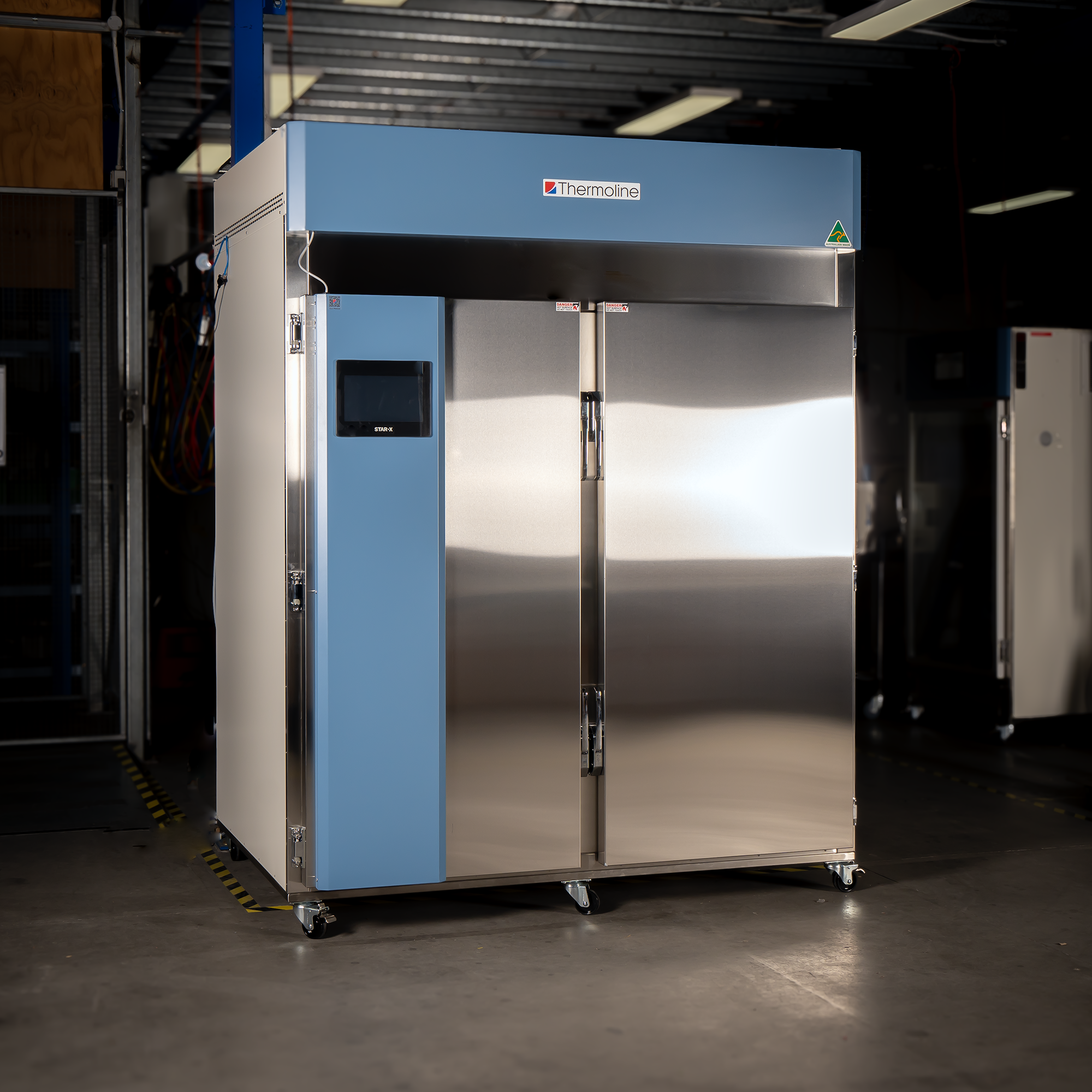
.png)
